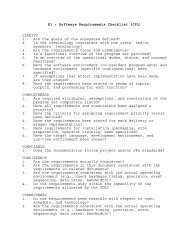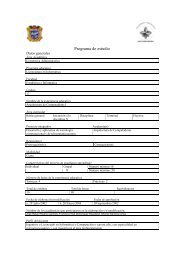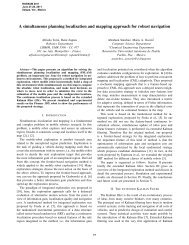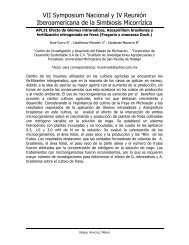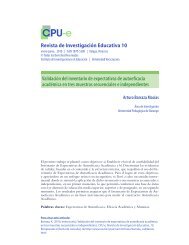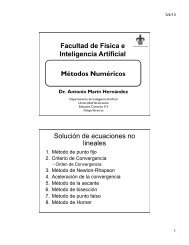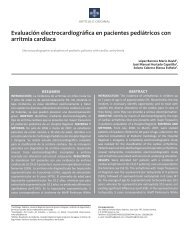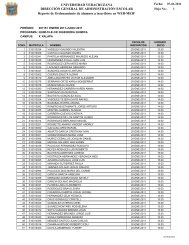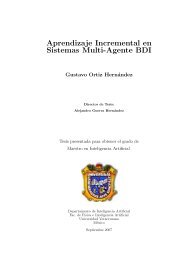Understanding the Software Options
Understanding the Software Options
Understanding the Software Options
Create successful ePaper yourself
Turn your PDF publications into a flip-book with our unique Google optimized e-Paper software.
A<br />
Department Editor: Scott Jenkins<br />
well designed and operated heat-transfer-fluid<br />
system is a key feature of a safe, reliable and<br />
cost-effective heating design. However, prob-<br />
lems can arise if <strong>the</strong> heat-transfer fluid becomes<br />
heavily degraded or <strong>the</strong> system is allowed to<br />
accumulate solids and o<strong>the</strong>r process contaminants.<br />
These problems include <strong>the</strong> following:<br />
• Reduced heat-transfer rates<br />
• Diminished fuel efficiency<br />
• Flow blockage in small-dia. or low-velocity areas<br />
• Extended startup times at low temperatures<br />
• Fouling of heat-transfer surfaces<br />
• Overheating, damage or failure of heater tubes<br />
Avoiding heat-transfer fluid degradation and contamination<br />
often requires <strong>the</strong> use of <strong>the</strong> following<br />
filtration, flushing and cleaning techniques.<br />
Filtration<br />
In many cases, filtration can effectively remove<br />
solids that, if left unchecked, may result in <strong>the</strong> need<br />
to drain and flush a system. In general, glass-fiberwound<br />
filter cartridges work well for in-system<br />
filtration of organic-liquid heat-transfer fluids.<br />
These filters are generally available from numerous<br />
manufacturers, are usable at temperatures up to<br />
400°C, typically have adequate solids-holding<br />
capacity and are usually economical and disposable.<br />
The filter housing should also be specified<br />
for <strong>the</strong> desired temperature and pressure. The filter<br />
should be installed where <strong>the</strong>re is a 20–40-psi<br />
pressure drop, and should have a maximum<br />
throughput of 1% of <strong>the</strong> system flowrate. For initial<br />
startup, a 100-µm-nominal particle removal rating<br />
is acceptable, and can be gradually reduced to<br />
a 10-µm-rated filter element for ongoing use. For<br />
heat-transfer fluids containing high concentrations<br />
of solids, bag filters or o<strong>the</strong>r high-surface-area<br />
designs may be preferred.<br />
When intensive system cleaning is necessary, it<br />
is recommended to incorporate sound environmental,<br />
health and safety principles into <strong>the</strong> job plan to<br />
protect against exposure to hot fluid and vapors.<br />
System drain<br />
Adjust <strong>the</strong> fluid temperature to 93°C and shut<br />
down <strong>the</strong> heater. Continue operating <strong>the</strong> circulating<br />
pumps as long as possible during pump-out<br />
to keep loose solids and sludge in suspension.<br />
Drain <strong>the</strong> system through all low-point drains.<br />
If gravity draining is not sufficient or possible,<br />
compressed nitrogen can be used to effectively<br />
blow additional fluid from <strong>the</strong> system. Remove as<br />
much degraded heat-transfer fluid as possible to<br />
maximize <strong>the</strong> following cleaning techniques. Caution<br />
must be exercised to avoid contact with hot<br />
fluid and piping. Once <strong>the</strong> fluid has been drained<br />
from <strong>the</strong> system it should be stored, handled and<br />
disposed of according to <strong>the</strong> product MSDS (material<br />
safety data sheet) and your environmental,<br />
safety and health professionals’ guidance. The<br />
system may <strong>the</strong>n be cleaned using one or more of<br />
<strong>the</strong> techniques in Table 1.<br />
System �ushing<br />
If a strainer is not already present in <strong>the</strong> system<br />
return line that runs to <strong>the</strong> main circulating pumps,<br />
consider <strong>the</strong> addition of a fine-mesh strainer to<br />
protect <strong>the</strong> circulation pumps from solids that may<br />
be dislodged during cleaning.<br />
When choosing a flushing fluid, ensure that<br />
it is compatible with <strong>the</strong> system components and<br />
<strong>the</strong> new replacement fluid. This can usually be determined<br />
by contacting <strong>the</strong> fluid manufacturer. In<br />
addition, avoid flush fluids that contain chlorine,<br />
as this may cause corrosion issues if a portion is<br />
left in <strong>the</strong> system.<br />
Fill <strong>the</strong> system from <strong>the</strong> low points with <strong>the</strong><br />
flushing fluid, including <strong>the</strong> expansion tank, to a<br />
normal operating level. Start circulating <strong>the</strong> entire<br />
system at ambient conditions to begin dissolving<br />
<strong>the</strong> organic solids and residual heat-transfer fluid.<br />
Periodically check <strong>the</strong> return line strainer for plugging<br />
and buildup of solids that may have been<br />
released during system cleaning. In accordance<br />
with <strong>the</strong> manufacturer’s recommendations, increase<br />
<strong>the</strong> fluid temperature to maximize cleaning<br />
potential and continue circulating for <strong>the</strong> directed<br />
time period. Cool <strong>the</strong> flushing fluid, <strong>the</strong>n drain it<br />
from <strong>the</strong> system through low points, ensuring that<br />
as much fluid is removed as possible, <strong>the</strong>n dispose<br />
of it properly.<br />
Chemical cleaning<br />
In some situations, alternative cleaning<br />
methods are required, such as cleaning of<br />
a vapor-phase heat-transfer system. In <strong>the</strong>se<br />
situations, chemical cleaning may be used as<br />
an alternative. In general, chemically cleaning<br />
a heat transfer system requires extra steps,<br />
higher cost, additional time and producessignificantly<br />
more waste. A general outline of a<br />
chemical cleaning procedure may include <strong>the</strong><br />
following:<br />
• Drain heat-transfer fluid from system<br />
• Solvent flush circulation<br />
• Drain solvent flush<br />
• Acidic solution circulation<br />
CONTAMINANTS<br />
AND THEIR SOURCES<br />
Rust, dirt and pipe scale: In most cases <strong>the</strong>se<br />
are introduced into <strong>the</strong> system during construction<br />
or maintenance.<br />
Oxidation: Occurs when hot heat transfer fluid<br />
comes in contact with air to form weak organic<br />
acids. Excessive oxidation can cause <strong>the</strong> formation<br />
of solids and high viscosity compounds<br />
which impair system effectiveness.<br />
Thermal degradation: Rate of <strong>the</strong>rmal degradation<br />
for any organic <strong>the</strong>rmal liquid depends on<br />
<strong>the</strong> fluid chemistry, system operating temperature<br />
and time. When degradation does occur<br />
<strong>the</strong> outcome typically includes higher molecular<br />
weight compounds and carbonaceous solids.<br />
Process contamination: If <strong>the</strong> heat transfer fluid<br />
is contaminated with process-side fluid, <strong>the</strong><br />
contaminant may form solids, sludge, decomposition<br />
and even reaction products.<br />
FACTS AT YOUR FINGERTIPS Sponsored by<br />
Heat transfer<br />
system cleaning<br />
TABLE 1<br />
Contaminants Cleaning techniques<br />
Solids • Filtration<br />
Sludge, highviscosity<br />
fluid<br />
or residues<br />
Process<br />
contamination<br />
• System drain<br />
• System flushing<br />
• Chemical cleaning<br />
• Unique<br />
procedure<br />
Hard coke • System drain<br />
• Mechanical cleaning<br />
• Caustic and detergent solution circulation<br />
• Flush with water<br />
• Dry thoroughly<br />
Mechanical cleaning<br />
In some cases, such as when <strong>the</strong> system has been<br />
severely fouled by hard coke deposits or <strong>the</strong> lines<br />
are completely blocked, <strong>the</strong> above methods are<br />
inadequate for cleaning <strong>the</strong> system. In <strong>the</strong>se cases,<br />
mechanical cleaning is most likely required.<br />
Mechanical cleaning methods can include highpressure<br />
water jetting, wire brushing, mechanical<br />
scraping and sand or bead blasting.<br />
After cleaning<br />
Once <strong>the</strong> system has been drained completely, it<br />
should be inspected for solids that may have fallen<br />
out of suspension, especially in low-velocity areas.<br />
Ensure that a side-stream filter is operational and<br />
properly maintained. If a side-stream filter is not<br />
present in <strong>the</strong> system, consider installing one to<br />
aid in solids removal during normal operation.<br />
Refill <strong>the</strong> system with fresh heat-transfer fluid<br />
and start up using normal procedures. Residual<br />
moisture may be present from <strong>the</strong> drain, cleaning<br />
and start up procedures. Care should be taken<br />
to vent any moisture from <strong>the</strong> system by allowing<br />
flow through <strong>the</strong> expansion tank where <strong>the</strong> moisture<br />
can flash and <strong>the</strong>n vent. It is also suggested to<br />
employ inert gas blanketing of <strong>the</strong> expansion-tank<br />
vapor space to prevent moisture and air contamination<br />
of <strong>the</strong> fluid. This is usually put in place<br />
after moisture has been vented and <strong>the</strong> system is<br />
brought up to operating temperature.<br />
References and fur<strong>the</strong>r reading<br />
1. Beain, A., Heidari, J., Gamble, C.E., Properly Clean<br />
Out Your Organic Heat-Transfer Fluid System, Chem.<br />
Eng. Prog., May 2001, pp. 74–77.<br />
2. Gamble, C.E., Cleaning Organic Heat Transfer Systems,<br />
Process Heating, Oct. 2002, pp. 39–41.<br />
3. Solutia Inc., “Therminol Information Bulletin no. 1:<br />
Cleaning Organic Heat Transfer Fluid Systems,” Pub.<br />
no. 7239011B, Solutia Inc., 2008.<br />
4. Solutia Inc., “Therminol Information Bulletin no. 3: Heat<br />
Transfer Fluid Filtration: How and Why,” Pub. no.<br />
7239123B, Solutia Inc., 2004.<br />
Editor’s note: Content for this edition of “Facts at<br />
Your Fingertips” was contributed by Solutia Inc.<br />
NOTICE: Although <strong>the</strong> information and recommendations set forth herein (hereinafter "Information") are presented in good faith and believed to be correct as of <strong>the</strong> date hereof, nei<strong>the</strong>r Solutia,<br />
nor any of its affiliates, makes any representations or warranties as to <strong>the</strong> completeness or accuracy <strong>the</strong>reof, and Solutia, and its affiliates, reserves <strong>the</strong> right to revise <strong>the</strong> Information without<br />
notice. Information is supplied upon <strong>the</strong> condition that <strong>the</strong> persons receiving same will make <strong>the</strong>ir own determination as to its suitability for <strong>the</strong>ir purposes prior to use. In no event will Solutia, or<br />
its subsidiaries, be responsible for damages of any nature whatsoever resulting from <strong>the</strong> use of or reliance upon Information or <strong>the</strong> product to which Information refers. Nothing contained herein<br />
is to be construed as a recommendation to use any product, process, equipment or formulation in conflict with any patent, and nei<strong>the</strong>r Solutia, nor any of its affiliates, makes any representation<br />
or warranty, express or implied, that <strong>the</strong> use <strong>the</strong>reof will not infringe any patent. NO REPRESENTATIONS OR WARRANTIES, EITHER EXPRESS OR IMPLIED, OF MERCHANTABILITY, FITNESS<br />
FOR A PARTICULAR PURPOSE OR OF ANY OTHER NATURE ARE MADE HEREUNDER WITH RESPECT TO INFORMATION OR THE PRODUCT TO WHICH INFORMATION REFERS.”



